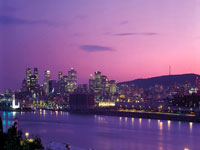 Montreal OverviewThe world's largest inland port, Montreal was founded as a
missionary village in 1642, a century after Jacques Cartier
discovered the area. The French stayed in control of the growing
settlement until 1760 when the British stepped in, sparking a now
centuries-old French resentment of the British interference.
Despite some undeniable English architectural and cultural
influences, Montreal is today one of the world's largest
French-speaking cities, set on an overwhelmingly English-speaking
continent, and a metropolis of international repute, framed between
Mont Royal and the St Lawrence River. The city is in the south of Canada's Quebec province, only 37
miles (60km) from the United States border, and is an important hub
of North American trade. It is a spacious, beautiful city
characterised by a series of underground shopping and recreation
complexes, linked by walkways and the metro. This subterranean city
contains more than 18.5 miles (30km) of office and apartment
complexes, major stores, hotels, restaurants, metro stations,
parking garages, movie theatres, concert halls and more, all snugly
accessible during the snowy winters. Its population is a multicultural mix, which has fostered a
vibrant cultural life, cemented by its French and British roots.
There are several theatres offering year-round theatre, ballet and
music performances, and a number of art galleries and museums. Like
most Canadian cities, Montreal has interspersed urban development
with green areas. In this case pride is taken by the spacious Parc
du Mont-Royal, designed by Frederic Olmsted, the American landscape
artist who also designed Central Park in New York. The city also
has 30 museums and numerous other attractions of interest to
visitors all year round. |